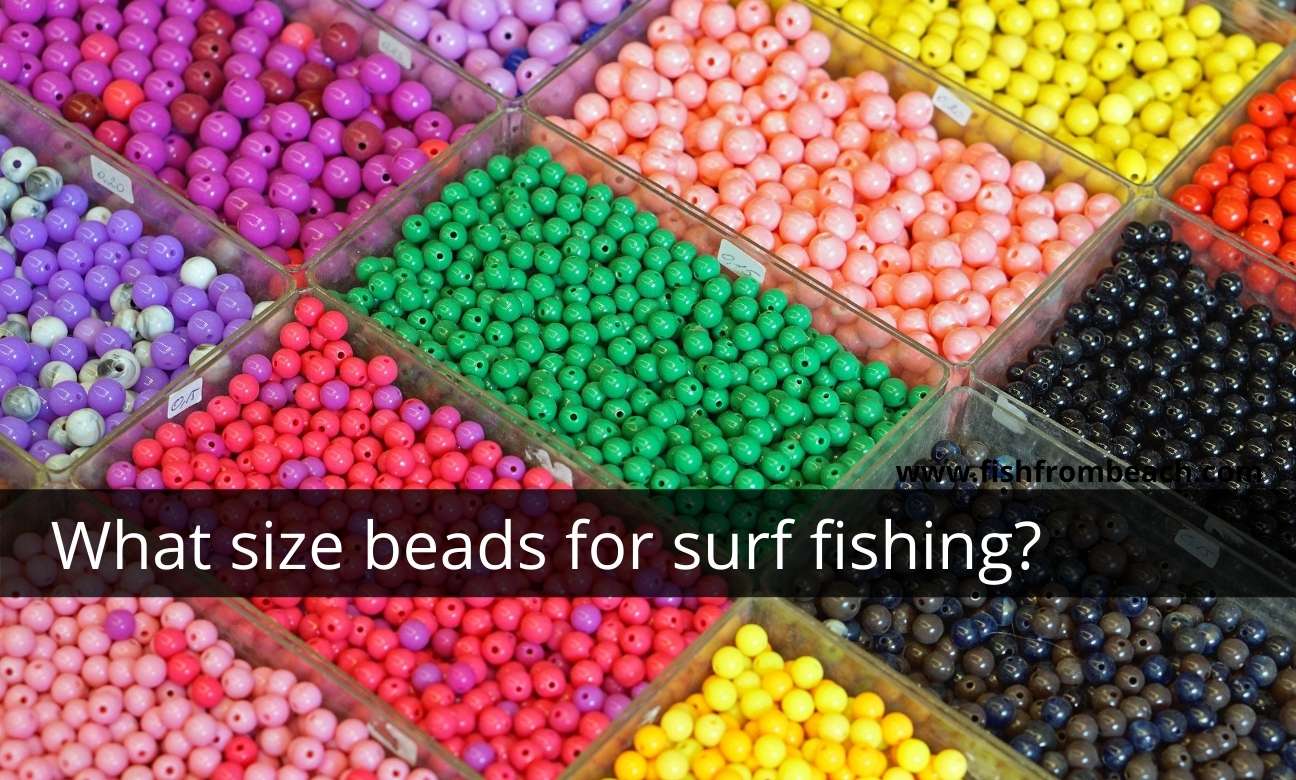Beads serve many purposes when surf fishing. From protecting knots to making baits more attractive to the fish, adding a bead to your setup can really help you be more productive on the beach and draw more fish to your offer.
But how to choose your beads? What size bead works best for surf fishing? And what are the other factors to consider when choosing a bead size?
That’s what we’re going to answer today. In this article, we’ll go over all the factors and variables to keep in mind when choosing a bead size for your surf fishing setups.
So let’s dive in.
Beads between 4 and 8 mm are the most common for surf fishing. Larger beads may seem scary to the fish and therefore can reduce the bite. Also, the holes of oversized beads can be wider than the knot or eye of the hook, which can be a hassle and hurt your overall productivity.
Why do we need beads for surf fishing?
Ok, let’s be clear here. You don’t always need beads when surf fishing.
Bare rigs that only incorporate hooks, sinkers, and leaders are the smartest choice in many situations. You may need to add swivels here and there to connect the pieces and make your life easier. But beads? I believe they are not super necessary and you can certainly do well without them.
However, it’s also worth noting that beads are rewarding in certain situations and can make your setup more productive and efficient.
Let’s review some of these cases.
Drawing the attention of fish
Fish are curious creatures. In general, they will investigate any unknown object they find in their territory.
Therefore, anglers must know how to take advantage of this and be able to attract fish to their offer.
This is where beads can come in handy. By throwing bright, colorful objects into the water, you can easily attract fish’s attention and encourage them to focus around your bait.
That’s a guaranteed way to get more bites.
Targeting sight feeders
Species like the pompano and whiting rely heavily on their eyesight for food. This means they are more attracted to things that look (not smell or sound) like food.
How do beads help with that?
Well, they help with fish that feed on crustaceans and shellfish. These creatures can sometimes be small and colorful (like coquina clams for example) and fish will have a hard time telling them apart from fishing beads.
In addition, beads are very similar to sand flea egg sacs, which are considered by many experienced anglers to be pompano’s favorite food.
Throwing beads when surfcasting will therefore help you mimic the real food of many species of fish, which can be very rewarding.
Producing sounds
Ok, that’s a theory that I don’t know if anyone has ever proven it.
The theory says that fishing beads produce clicking sounds underwater, which attracts the attention of fish and encourages them to approach.
So if this is really true, then beads not only help catch sight feeders, but also species that become curious when they hear strange sounds around.
Worth a try, right?
Using some rigs
Beads are not only used to attract the attention of fish, but also to make certain rigs work more efficiently.
For example, when using a Carolina rig or fish finder rig, you should add a bead before connecting the leader so that it stops the moving sinker and prevents it from sliding down to the hook .
Well, I can simply use a bigger swivel and it will act as a stopper without needing an extra bead? Is that correct?
Yes, you can definitely go with that. But note that the bead also protects the knot connecting the swivel and cushions the shocks caused by the sinker as it slides up and down with the water current.
The bead is therefore not a luxury item here. It is an essential component and without it the rig will not work as expected.
Beads also reduce the risk of wind knots and line twists and help separate the different elements in your setup. This can be useful when surf fishing in choppy waters that mess up your terminal gear.

What to consider when choosing a bead size for surf fishing?
Now that we’ve covered the different reasons we use beads, it’s time to discuss which bead size is best for surf fishing.
The answer here depends on why you want to add a bead to your setup.
In other words, the best size bead for surf fishing is the size that serves the purpose behind using the bead.
For example, if you want the bead to draw the attention of sight feeders, then make sure its size matches what your targeted species usually eat.
A visit to the beach at low tide is usually worthwhile here. The objective is to locate underwater structures and observe the size of clams, molluscs and various shellfish in the region. This is also a good time to see what the egg sacs of certain crustaceans look like.
Gather as much information as you can, then try to match your bead size to that.
Likewise, if you want the bead to stimulate fish curiosity, be sure to match its size to what makes your target species curious.
Don’t make it too small so it won’t go unnoticed, but not too big so it looks suspicious and scary.
A good online search about your favorite fish always helps. Also, don’t be afraid to ask local anglers and tackle providers what works and what doesn’t in this regard.
The bead size should not interfere with your rig
Having said all of that, it’s very important to remember that the bead size should not impair your rig.
This means that if what you see in your area are only 2 inch clams and shellfish, don’t use 2 inch beads in your rigs. This can be counterproductive and cause many problems.
Likewise, if your targeted fish only likes beads the size of a gulf ball, don’t just go and use that.
Large beads tend to receive more pressure from wind and water currents, which affects casting distance and stability in the surf.
Also, if you’re using a bead as a stopper in your Carolina or Fish Finder rig, you don’t want to make it too big because it could slip down the hook.
And of course, needless to say that a big red or orange ball in the water can scare off a lot of fish and therefore reduce the bite.
So what is the best size bead for surf fishing?
Beads between 4 and 8 mm are most of the time all you need for surf fishing.
I really don’t see any solid reason to go beyond that. Maybe 12mm is the upper limit here, just to provide more headroom.
Personally, I only use 4-8mm beads and they work pretty well for attracting sight feeders and curious fish, without compromising the effectiveness of my rigs.
Some recommended surf fishing gear(*)
Note (*): If you make a purchase through links from this website, we may get a small share of the sale from Amazon or other similar affiliate programs.
Surf Fishing Survey
Help us provide you with better content by answering simple questions about your surf fishing experience and knowledge.
We will put the collected responses together and turn them into valuable information that will help you catch more fish from shore 😉
Note: No personal information will be collected with your answer.

